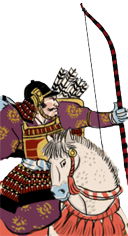
Basic Unit Statistics (can be modified by difficulty level, arts, skills, traits and retainers)
| Recruitment Cost | 750 | |
| Upkeep Cost | 200 | |
| Melee Attack | 6 | 17% |
| Charge Bonus | 10 | 20% |
| Bonus vs Cavalry | 0 | 0% |
| Range | 150 | 23% |
| Accuracy | 60 | 60% |
| Reloading Skill | 30 | 30% |
| Ammunition | 25 | 31% |
| Melee Defence | 2 | 5% |
| Armour | 4 | 26% |
| Morale | 10 | 20% |
Strengths & Weaknesses
- Fast and can fire on the move.
- High accuracy and range.
- Weak against massed foot missile units.
- Weak in melee.
Abilities
- Swooping Crane - This unit can arrange itself into a moving circular formation, harrassing the enemy with a constant rate of fire.
Requires
Description
Trained to aim and fire a bow while riding, these samurai make excellent skirmishers.
With both hands occupied by aiming and firing a bow, these men must use their knees to control and steer their mounts. Japan has a long tradition of mounted archery and these troops remain invaluable despite the introduction of gunpowder. Matchlocks may be powerful, but they are also unreliable and inaccurate, and the ashigaru who use them simply lack the skills and mobility of mounted samurai. These cavalry archers can quickly move to the flanks of an enemy, or harass the enemy at a distance. If caught in melee, they have enough training to defend themselves, but they should avoid fighting spearmen or heavy cavalry. The introduction of arquebuses in the Sengoku Jidai threatened Japan's ancient tradition of mounted archery. Guns meant that a daimyo could bolster his army with large numbers of arquebus-armed ashigaru rather than relying on the skilful, but less numerous, samurai. Fortunately for the samurai, horse archery was too important a tradition to die out, and the art survived. For training, they would shoot at corralled dogs, or at wooden targets while speeding along a set course. The latter training method, called 'yabusame' is still practiced today at special demonstrations for visiting dignitaries, and participation is considered a great honour.
